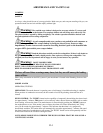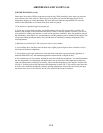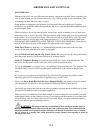
AIRSTREAM LAND YACHT GAS
CLEANING YOUR DETECTOR:
To clean your detector remove it from the mounting bracket as outlined in the beginning of this section.
You can clean the interior of your detector (sensing chamber) by using your vacuum cleaner hose and
vacuuming through the openings around the perimeter of the detector.
The outside of the detector can be wiped with a damp cloth.
AFTER CLEANING, REINSTALL YOUR DETECTOR. TEST YOUR DETECTOR BY USING
THE TEST BUTTON.
LIMITATIONS OF SMOKE ALARMS:
WARNING Smoke detectors are devices that can provide early warning of possible fires at
a reasonable cost; however, detectors have sensing limitations. Ionization type detectors offer a broad
range of fire sensing capability but are better at detecting fast flaming fires than slow smoldering
fires. Photoelectric detectors sense smoldering fires better than flaming fires. Home fires develop in
different ways and are often unpredictable. Neither type of detector (photoelectric or ionization) is
always best, and a given detector may not always provide warning of a fire. Also, smoke detectors do
have limitations. For a battery powered detector the battery must be of the specified type, in good
condition, and installed properly. AC powered detectors will not operate if AC power has been cut
off such as by an electrical fire or an open fuse. Smoke detectors must be tested regularly to make
sure the batteries and the detector circuits are in good operating condition.
Smoke detectors cannot provide an alarm if smoke does not reach the detector. Therefore, smoke
detectors may not sense fires starting in chimneys, walls, on roofs, on the other side of a closed door
or on a different floor. If the detector is located outside the bedroom or on a different floor, it may
not wake up a sound sleeper. The use of alcohol or drugs may also impair ones ability to hear the
smoke alarm. For maximum protection a smoke detector should be installed in each sleeping area on
every level of a home.
Although smoke detectors can help save lives by providing an early warning of a fire, they are not a
substitute for an insurance policy. Homeowners and renters should have adequate insurance to
protect their lives and property.
GOOD SAFETY HABITS
DEVELOP AND PRACTICE A PLAN OF ESCAPE:
• Make a floor plan indicating all doors and windows and at least two (2) escape routes from each
room. Second story windows may need a rope or chain ladder.
• Have a family meeting and discuss your escape plan, showing everyone what to do in case of fire.
• Determine a place outside your home where you all can meet if a fire occurs.
• Familiarize everyone with the sound of the Smoke Alarm and train him or her to leave your home
when they hear it.
• Practice a fire drill at least every six months. Practice allows you to test your plan before an
emergency; you may not be able to reach your children. It is important they know what to do.
D-3


















